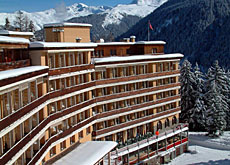Davos mountains still work their magic

Davos is as unique as the annual meeting of the World Economic Forum (WEF) which it hosts.
As well as being the setting for the WEF meeting, Davos is a centre for research and claims to be the “highest altitude town in Europe”. What it is not is a typical Swiss ski resort.
Arriving in Davos, visitors are often surprised to find it is dominated by flat-roofed rectangular buildings instead of a collection of chalet-style hotels of the kind found throughout the Alps.
A health resort in the 19th and early 20th century (see story under “related items”), Davos now houses a thriving and diverse community.
Skiing is the number one activity here, but whereas hotels in other resorts are shuttered up once the last skiers leave in spring, Davos flourishes year round.
It welcomes countless conferences and seminars, and is home to clinics and medical centres as well as a leading institute for snow and avalanche research.
Located at 1,500m, Davos also attracts top athletes who want to train at altitude, and its premier league ice hockey club puts the spotlight on the resort each December when it plays host to the prestigious Spengler Cup tournament.
Five mountains
Skiers have no less than 320km of runs at their disposal, spread across the five mountains surrounding the resort.
And they and everybody else looking for a room have no trouble since the town boasts 24,000 hotel beds. Since Davos is strung along the valley floor for several kilometres it often fills up, but is never full to overflowing.
“The town’s got everything you need – opticians, computer shops, 24-hour outlets. There even used to be a sex shop here,” says Briton David Sincock.
The facilities are an added bonus for Sincock who chose to make Davos the base for his new company focusing on off-piste skiing.
“White Heat” teaches deep snow skiing skills with the aid of video analysis (see video).
British are back
There is a renewed interest from Britain in Davos, even though the total number of British visitors to the Swiss Alps as a whole has been stagnating for years.
Davos saw an increase of around five per cent in British guests last winter, and is expected to see a similar rise this year.
The increase coincided with a major upgrading of the resort’s lift facilities, which has greatly reduced waiting times on the slopes.
“We have a big advantage which tour operators are aware of: the wide variety of things to do, which means tour operators can sell more than skiing, they can also promote activities for families and non-skiers,” says tourist director Armin Egger.
“This strength of ours cannot be copied by any other alpine resort.”
Marion Telsnig of the British tour operator, Crystal Holidays, says Davos meets the key requirement of having “good infrastructure” and is sought out by travellers demanding “quality”.
“It’s very different. It’s a working town, but there are real ‘chocolate box’ Swiss villages close by which you don’t find in France, where there tend to be more large-scale, purpose-built resorts,” says one convinced tourist.
“It’s easy to get to,” he continues. “You can jump off a plane in Zurich and be in the resort by train in a few hours, which you couldn’t do in France.”
Sanatoria
Many of Davos’s former sanatoria have long been converted into hotels. The grid-like balconies were designed so that chronically ill patients could lie outside to soak up the healing powers of the sun and fresh mountain air.
Resembling exoskeletons, the balconies are now used by holidaymakers stepping outside in the morning to ascertain the weather and choose a mountain for their day’s skiing.
The plethora of these buildings remaining in Davos also reassures guests that they have come to a place that has not forgotten its past.
And why should it? Thomas Mann set his epic work The Magic Mountain here. Sir Arthur Conan Doyle came to be cured and ended up making a significant contribution to the development of alpine skiing.
The German expressionist, Ernst Ludwig Kirchner, made Davos his home, capturing the mountains on his canvas in pink and violet.
The Kirchner museum, with over 500 works by the artist, is the most important of the town’s six museums.
The latest celebrity artists wanting to make their mark on the mountainous landscape are the star Swiss architects, Herzog and de Meuron, who are planning to build a new-age tower hotel beside a former sanatorium.
Such a monument on this scale does not exist anywhere in the Swiss Alps.
But then again, this is Davos.
swissinfo, Dale Bechtel in Davos
Davos lies at 1,560m and has a year round population of 13,000.
It became a health resort in the mid-19th century when a German doctor, Alexander Spengler, recognised the beneficial effect of a high-altitude climate.
Sir Arthur Conan Doyle was among the illustrious patients in the early decades, along with the wife of Thomas Mann.
The first annual meeting of the World Economic Forum took place in 1971.

In compliance with the JTI standards
More: SWI swissinfo.ch certified by the Journalism Trust Initiative











You can find an overview of ongoing debates with our journalists here . Please join us!
If you want to start a conversation about a topic raised in this article or want to report factual errors, email us at english@swissinfo.ch.